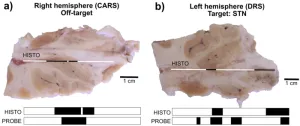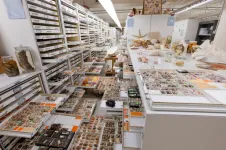(Press-News.org) UNIVERSITY PARK, Pa. — U.S. college students’ knowledge of bees focuses primarily on honey bees and pollination services, according to Penn State researchers, who said findings from their recent study could help in designing campaigns to generate support for protecting threatened pollinators.
Wild and managed bee populations have been in steep decline worldwide in recent years, noted study co-author Christina Grozinger, Publius Vergilius Maro Professor of Entomology and director of the Center for Pollinator Research in the College of Agricultural Sciences.
“In the United States, 30% or more of honey bee colonies die each winter, and studies suggest that populations of a quarter of all bee species globally, including half of bumble bee species, have fallen significantly,” she said. “These declines have serious implications for natural ecosystems, agriculture and human nutrition.”
About 80% of flowering plants — and three-fourths of major food crops such as fruits and vegetables — rely on pollination from animals, with bees being the most important pollinators, Grozinger explained.
Study lead author Shannon Cruz, assistant professor of communication arts and sciences in the College of the Liberal Arts, contends that to address bee species declines, the public needs to engage in conservation efforts, but research on how best to promote such behavior is limited.
“Many initiatives have focused on education as the solution to this problem, but education alone often isn’t enough to produce attitude and behavior change,” Cruz said. “Such change also may require communication campaigns that not only explain how to protect pollinators, but persuade people they should protect them. Research indicates that this type of persuasive messaging is likely to be most effective if it’s designed based on what people already know about an issue.”
The researchers said previous studies suggest that public awareness of the breadth and diversity of bee species — which number more than 400 in Pennsylvania, 4,000 in the U.S. and 20,000 globally — is low and that people tend to have better knowledge of honey bees than of other bee species, even though honey bees are not representative of most species.
To craft persuasive messages that are effective even among people with low awareness, more in-depth studies are needed, the researchers noted. So, they set out to develop a novel approach to examining knowledge using semantic network analysis and content coding.
This type of analysis enables researchers to gauge the content of subjects’ knowledge of a topic based on their expression of words and concepts. By mapping the relationships between these words and concepts, researchers can better understand not just what the subjects know, but how they connect concepts to one another and organize this knowledge cognitively.
“Recent communication research suggests that arguments that incorporate more central concepts in a semantic network will be stronger and more persuasive than arguments that incorporate more peripheral concepts,” Cruz said. “The implication is that if we understand which concepts are most central to public knowledge of bees, we can also determine which concepts to focus on when developing persuasive messages to promote bee conservation.”
As their subjects, the researchers chose undergraduate students, with an eye toward examining the content and structure of their self-reported knowledge of bees and identifying the central concepts that might form the most promising basis for persuasive messages on bee conservation. They also looked at whether central concepts and the accuracy of bee knowledge differed in two audiences — a high-interest group enrolled in a course specifically on honey bees, and a low-interest group enrolled in psychology classes.
Participants completed a survey that asked questions such as, “What do you know about bees? Please write down anything that comes to mind.” The researchers analyzed responses word by word using a software program, which tabulated how often each word appeared and how often two words occurred together (within three words of each other) in the text.
Researchers also coded responses manually to evaluate the accuracy of students’ knowledge on a scale of 1 (completely false) to 5 (completely true). In addition, they separated statements based on whether they focused on bees in general or on honey bees only.
Their findings, published recently in Conservation Science and Practice, indicated that the concepts most central to students’ understanding of bees — such as produce, honey, hive and queen bee — tended to be specific to honey bees. The words “people” and “pollination” also were central, which suggests that participants’ understanding focused mainly on the value bees provide to humans through honey production and pollination of crops and flowers.
These patterns also held true when looking at the low- and high-interest students separately. The main difference between the two groups was that “sting” was among the most central concepts for the low-interest students but not for the high-interest students. These findings suggest that students in general have a honey-bee-centered, utilitarian understanding of bees and that the fear of being stung is more prominent among those with low interest in bees.
Both groups’ knowledge of bees was relatively accurate but shallow, the researchers said. Students’ understanding of honey bees was much more accurate than their knowledge of bees in general, and they frequently assumed that facts about honey bees were true of all bees.
“Because honey bees typically are managed and not representative of most wild bee species, some researchers have argued that focusing conservation efforts on honey bees is counterproductive,” Grozinger said. “But our findings show that because concepts like ‘honey’ were central to how students organized their knowledge, honey bees may still be among the best ambassadors for bee and pollinator conservation.”
Cruz noted that the findings do not mean that focusing solely on honey bees will be effective in promoting the conservation of other species.
“Instead, honey bees can serve as a familiar place to start, before transitioning into a discussion of other bees and pollinators,” she said. “By drawing connections between other bee species and honey bees, we can help tap into existing knowledge structures, making behaviors like native bee conservation more familiar and appealing than they might be otherwise.”
The Communication, Science, and Society Initiative, a partnership between Penn State's Department of Communication Arts and Sciences and the Huck Institutes of the Life Sciences, provided funding for this study.
END
Study: Mapping people’s knowledge of bees may aid in pollinator conservation
The public knows honey bees, but awareness of wild bee species is low, researchers say
2023-03-23
ELSE PRESS RELEASES FROM THIS DATE:
Spectroscopy probe could enhance deep brain stimulation procedure for Parkinson’s
2023-03-23
VANCOUVER -- Deep brain stimulation (DBS) has become an increasingly common treatment for patients with advanced Parkinson’s disease, but the procedure still carries significant risks. A new probe that performs two types of spectroscopy could make the procedure safer and improve success rates by helping doctors more accurately navigate instruments inside the brain. The research team identified white and grey matter using principal component analysis (PCA), proving that spectroscopic measurements could be suitable for neuronavigation.
For DBS, surgeons place electrodes in the brain to disrupt the errant signals that cause debilitating tremors and stiffness associated ...
Habitat will dictate whether ground beetles win or lose against climate change
2023-03-23
UNIVERSITY PARK, Pa. — The success of North American crops from corn to Christmas trees partly depends on a relatively invisible component of the food web — ground beetles. Nearly 2,000 species of ground beetle live in North America. New research led by Penn State shows that some of these insects could thrive while others could decline as the climate changes. The team found that the response will largely depend on the species’ traits and habitats and could have significant implications for conservation efforts.
“We know that climate change influences everything from coral reefs in the ocean to trees on land, but there’s ...
CDC report shows overall and Maryland autism rate increase among 8-year-olds
2023-03-23
Researchers at the Johns Hopkins Bloomberg School of Public Health contributed to a new Centers for Disease Control and Prevention report that found a continued rise in the overall prevalence of autism among 8-year-olds in 2020, the year the data was collected, as well as notable sex and racial/ethnic trends. In Maryland, the autism rate among 8-year-olds also rose, but it was the lowest prevalence among 11 sites that contributed to the study.
Autism spectrum disorder (ASD) is a developmental disorder that can be characterized by social and communication challenges, along with limited interests and repetitive behaviors.
The prevalence of ASD has risen steadily ...
Court ruling on PrEP could lead to more than 2,000 HIV infections in the next year
2023-03-23
A recent U.S. federal court ruling that removes a requirement for employers to provide insurance coverage for the HIV prevention medications known as Pre-Exposure Prophylaxis, or PrEP, could result in more than 2,000 entirely preventable HIV infections in the coming year, according to a new study led by researchers at the Yale School of Public Health.
The study addresses the potential consequences of a September 2022 decision by U.S. District Judge Reed O’Connor of Texas in a case known as Braidwood Management v. Becerra. O’Connor ruled in favor of the plaintiffs, a group of Christian business owners who claimed that federal mandates requiring private insurance ...
USC Norris collaborates with Auransa on clinical trial of new targeted treatment for liver cancer and other solid tumors
2023-03-23
The University of Southern California (USC) is collaborating with Auransa Inc., on a phase 1 clinical trial to evaluate a new kind of treatment for cancers of the liver and solid tumors with liver dominant disease. The drug, known as AU409, was developed by Auransa, a clinical stage drug development company focused on identifying novel drug candidates for oncology, inflammatory diseases and diseases of the central nervous system. In preclinical trials, AU409, has been shown to work in a unique fashion by limiting the cancer cell’s ability to translate the message from various genes ...
Global natural history initiative builds groundbreaking database to address 21st century challenges
2023-03-23
March 23, 2023 – Washington, DC, New York, NY, and London, England – A group of natural history museums, organized by the Smithsonian National Museum of Natural History in Washington DC, the American Museum of Natural History Museum in New York City, and the Natural History Museum in London, has mapped the total collections from 73 of the world’s largest natural history museums in 28 countries. This is the first step of an ambitious effort to inventory global holdings that can help scientists and decisionmakers find solutions to urgent, wide-ranging issues such as climate ...
Eye color genes are critical for retinal health
2023-03-23
Metabolic pathways consist of a series of biochemical reactions in cells that convert a starting component into other products. There is growing evidence that metabolic pathways coupled with external stress factors influence the health of cells and tissues. Many human diseases, including retinal or neurodegenerative diseases, are associated with imbalances in metabolic pathways. Elisabeth Knust leads a team of researchers from the Max Planck Institute of Molecular Cell Biology and Genetics (MPI-CBG) in Dresden, Germany, who describe an essential role for one ...
Can insights from the soapbark tree change the way we make vaccines?
2023-03-23
The medicinal secrets of the Chilean soapbark tree have been laid bare, unlocking a future of more potent, affordable, and sustainably sought vaccines.
The evergreen species, Quillaja saponaria has, for decades, been highly prized for producing molecules called QS saponins, which are used in the food and drinks industry as foaming agents.
More recently an important new function has emerged with saponins obtained from the tree’s bark used as potent adjuvants in the production of vaccines. Adjuvants play a critical role in some vaccines, working to boost the potency of a vaccine by enhancing the host immune response.
Molecules extracted from soapbark tree are ...
Autism rates continue to rise in California
2023-03-23
A new report from the Centers for Disease Control and Prevention (CDC) shows the rates and demographics of children with autism spectrum disorder (ASD) are changing in the United States.
In the latest analysis, 1 in 36 8-year-old children (2.8%) have been identified as having ASD. This figure is higher than the previous estimate published in December 2021, which found a prevalence of 1 in 44 (2.3%) children, and considerably higher than the CDC’s first autism prevalence report published in 2007 noting a prevalence of 1 in 150 (0.7%).
Prevalence estimates also differed across the 11 data collection sites, ranging from 1 in 43 children (2.3%) in Maryland, to 1 in 22 (4.5%) ...
Artificial intelligence predicts genetics of cancerous brain tumors in under 90 seconds
2023-03-23
Using artificial intelligence, researchers have discovered how to screen for genetic mutations in cancerous brain tumors in under 90 seconds — and possibly streamline the diagnosis and treatment of gliomas, a study suggests.
A team of neurosurgeons and engineers at Michigan Medicine, in collaboration with investigators from New York University, University of California, San Francisco and others, developed an AI-based diagnostic screening system called DeepGlioma that uses rapid imaging to analyze tumor specimens taken during an operation and detect genetic mutations more rapidly.
In a study of more than 150 patients ...
LAST 30 PRESS RELEASES:
Heart-brain connection: international study reveals the role of the vagus nerve in keeping the heart young
Researchers identify Rb1 as a predictive biomarker for a new therapeutic strategy in some breast cancers
Survey reveals ethical gaps slowing AI adoption in pediatric surgery
Stimulant ADHD medications work differently than thought
AI overestimates how smart people are, according to HSE economists
HSE researchers create genome-wide map of quadruplexes
Scientists boost cell "powerhouses" to burn more calories
Automatic label checking: The missing step in making reliable medical AI
Low daily alcohol intake linked to 50% heightened mouth cancer risk in India
American Meteorological Society announces Rick Spinrad as 2026 President-Elect
Biomass-based carbon capture spotlighted in newly released global climate webinar recording
Illuminating invisible nano pollutants: advanced bioimaging tracks the full journey of emerging nanoscale contaminants in living systems
How does age affect recovery from spinal cord injury?
Novel AI tool offers prognosis for patients with head and neck cancer
Fathers’ microplastic exposure tied to their children’s metabolic problems
Research validates laboratory model for studying high-grade serous ovarian cancer
SIR 2026 delivers transformative breakthroughs in minimally invasive medicine to improve patient care
Stem Cell Reports most downloaded papers of 2025 highlight the breadth and impact of stem cell research
Oxford-led study estimates NHS spends around 3% of its primary and secondary care budget on the health impacts of heat and cold in England
A researcher’s long quest leads to a smart composite breakthrough
Urban wild bees act as “microbial sensors” of city health.
New study finds where you live affects recovery after a hip fracture
Forecasting the impact of fully automated vehicle adoption on US road traffic injuries
Alcohol-related hospitalizations from 2016 to 2022
Semaglutide and hospitalizations in patients with obesity and established cardiovascular disease
Researchers ‘listen in’ to embryo-mother interactions during implantation using a culture system replicating the womb lining
How changing your diet could help save the world
How to make AI truly scalable and reliable for real-time traffic assignment?
Beyond fragmented markets: A new framework for efficient and stable ride-pooling
Can shape priors make road perception more reliable for autonomous driving?
[Press-News.org] Study: Mapping people’s knowledge of bees may aid in pollinator conservationThe public knows honey bees, but awareness of wild bee species is low, researchers say



